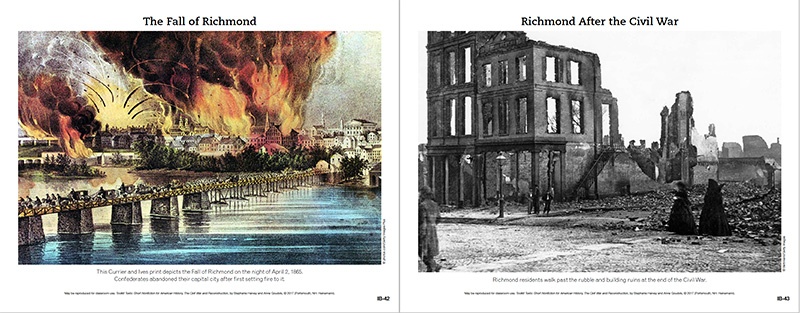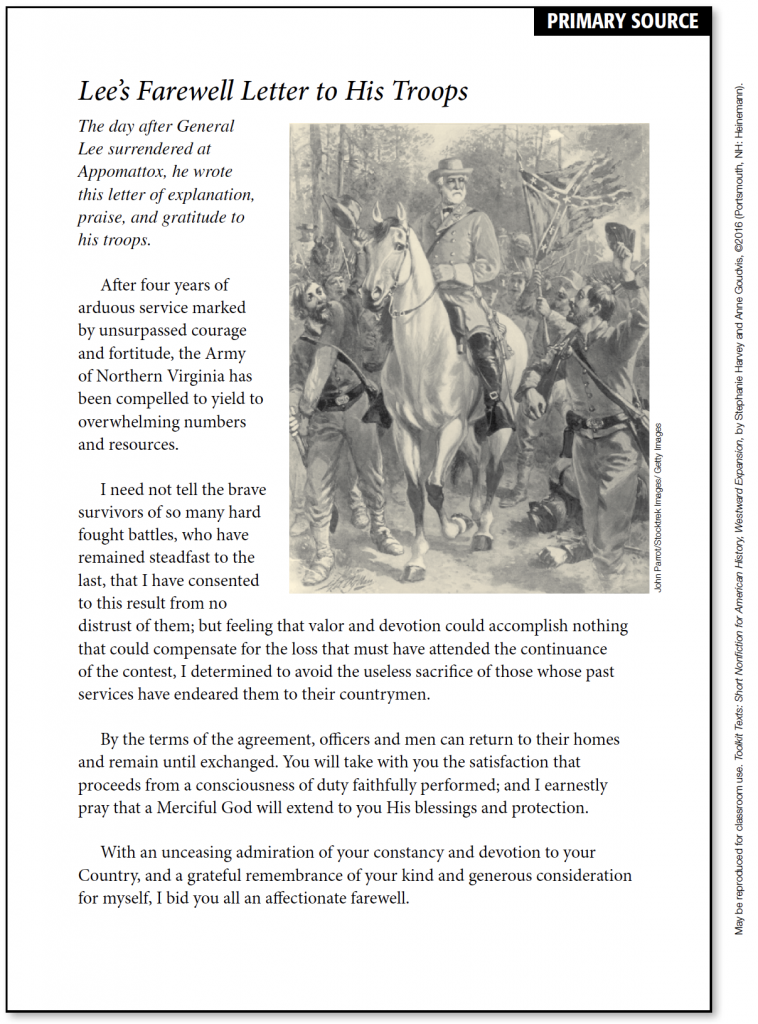
Today we commemorate the surrender at Appomattox, which occurred on April 9, 1865. Generals Grant and Lee met at the McLean House to end the four long, bloody years of the Civil War.
Our new resource, Toolkit Texts for American History: Civil War and Reconstruction, examines the people, events, and issues of this time period through a variety of materials, including:
- articles and short text
- primary-source texts and images
- maps
- photographs
- political cartoons
- prints and paintings
- timelines
These images and features introduce students of all ages to Civil War content and encourage differentiation for all students. Teaching kids to think critically about and analyze photographs, maps, paintings, and primary sources is essential if they are going to come to a deeper understanding of Civil War history.
The lessons shared here teach students to annotate, infer, question, and discuss images and primary sources as multiple entry points into this topic. When using rich historical images, combined with primary sources and other texts, kids engage in thinking-intensive learning. Projecting full-color versions from the online image bank, teachers invite students to activate their background knowledge and respond with their thinking.
Annotating and interpreting images is a powerful thinking tool. With the teacher’s guidance, students view and observe closely, leave tracks of their thinking, and discuss their questions, inferences and interpretations.
These questions guide our annotations and discussion:
- Who created this and why?
- When I look at this part of the image, I wondered…
- What can we infer from this image and other information that we viewed or read?
- How does this image help us understand the time period?
Lesson
The Final Days of the Civil War
Engage the kids in a discussion of the following: “Think about these two images. Consider how they foreshadow what will happen to end the war. Let’s talk about what we notice and observe about the image, especially inferences we can draw from it and questions we have. How do these images help us understand the end of the War?”


Students annotate both the historical print and the photograph with their questions and inferences. One great way to do this is to annotate digitally. Next, they discuss with small groups and share their thinking.
Surrender at Appomattox and the Aftermath
Analyze the primary source Lee’s Farewell Letter to His Troops

Engage the kids in a discussion of the purpose of the letter and the ways in which Lee honored the service of his troops. Kids can annotate the letter in pairs, and then come back to discuss the themes and perspectives it represents.
Next, ask kids to work in pairs or small group to compare and contrast the mood and tone of the letter with the images of Richmond.We’d argue powerful images and authentic primary sources will make history exciting to kids, so that they will continue to want to learn about it.
 Stephanie Harvey has spent her career teaching and learning about reading and writing. After fifteen years of public school teaching, both in regular education and special education classrooms, Stephanie worked for twelve years as a staff developer for the Denver based Public Education and Business Coalition (PEBC), a partnership of leaders from education and business, who support innovation in public schools.
Stephanie Harvey has spent her career teaching and learning about reading and writing. After fifteen years of public school teaching, both in regular education and special education classrooms, Stephanie worked for twelve years as a staff developer for the Denver based Public Education and Business Coalition (PEBC), a partnership of leaders from education and business, who support innovation in public schools.
Insatiably curious about student thinking, she is a teacher first and foremost and currently serves as a private literacy consultant to schools and school districts. In that role, she conducts keynote speeches, presentations, workshops, demonstration lessons, coaching sessions and ongoing consultation to teachers, reading specialists, literacy coaches, principals and district administrators. With a focus on K-12 literacy, her specialties include comprehension instruction, inquiry-based learning, content area reading and writing, nonfiction literacy, and the role of passion, wonder, and engagement in teaching and learning.
 Anne Goudvis is the coauthor the Heinemann title Comprehension Going Forward and of Strategies that Work (with Stephanie Harvey). She and Steph also created best-selling classroom materials The Comprehension Toolkit; The Primary Comprehension Toolkit; and Comprehension Interventions.
Anne Goudvis is the coauthor the Heinemann title Comprehension Going Forward and of Strategies that Work (with Stephanie Harvey). She and Steph also created best-selling classroom materials The Comprehension Toolkit; The Primary Comprehension Toolkit; and Comprehension Interventions.
Anne has been a classroom teacher, staff developer, and university instructor. For the past fifteen years, she has worked as a staff developer with the Denver-based Public Education and Business Coalition and currently does staff development in schools around the country. Recent interests include working in schools with culturally and linguistically diverse students and integrating reading comprehension instruction with content area topics in social studies and science.


